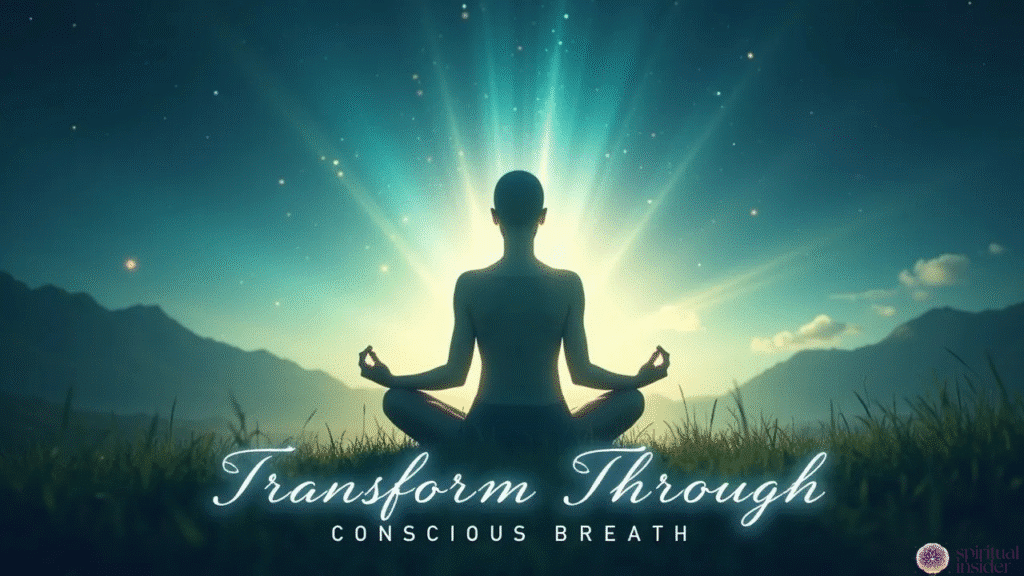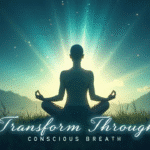The ancient practice of guided mindful breathing meditation has captured the attention of modern science and wellness communities worldwide.
This powerful technique combines traditional meditation wisdom with contemporary understanding of how controlled breathing affects our nervous system.
Unlike simple relaxation exercises, guided mindful breathing meditation creates a structured pathway to inner peace through focused breath awareness.
The practice involves following instructions while maintaining conscious attention on your breathing patterns and sensations.
The Ancient Art of Conscious Breathing
Navy SEALs and Buddhist monks both understand something profound about breath control that most people overlook.
While we breathe automatically throughout our lives, conscious breathing transforms this basic function into a gateway for transformation.
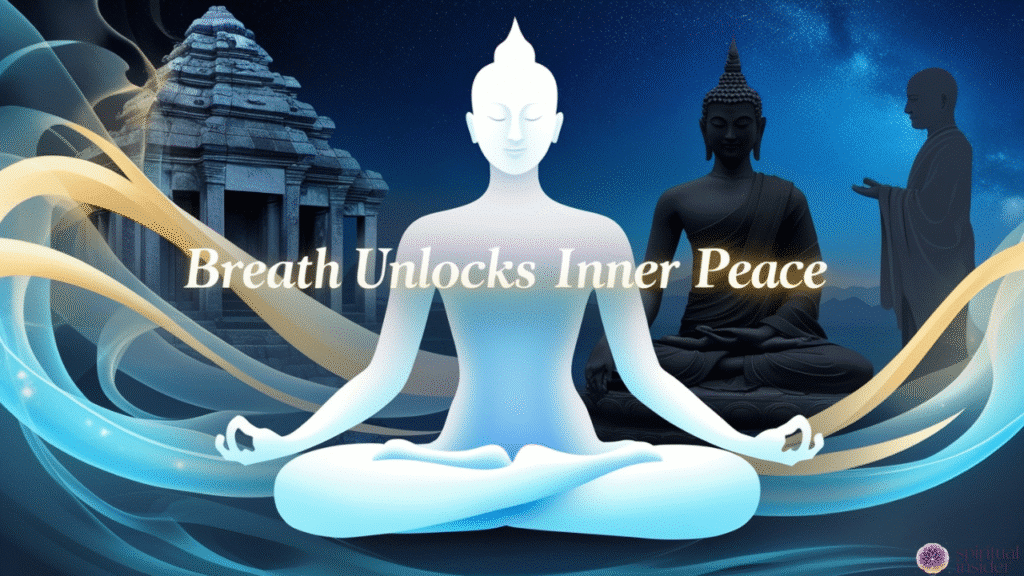
The disconnect between automatic breathing and intentional practice represents one of the most overlooked opportunities for personal growth.
When we breathe unconsciously, we miss countless chances to regulate our emotional states and enhance mental clarity.
Guided breathing meditation differs significantly from simple relaxation techniques because it engages your awareness actively rather than passively.
This engagement creates neurological changes that extend far beyond the meditation session itself.
Research shows that structured breathing practices can reduce cortisol levels by up to 23% within just four weeks of consistent practice.
The transformative potential includes improved stress resilience, enhanced focus, and better emotional regulation.
| Breathing Type | Awareness Level | Benefits |
|---|---|---|
| 😴 Automatic | Unconscious | Basic survival |
| 😌 Relaxed | Semi-conscious | Mild stress relief |
| 🧘 Guided Mindful | Fully conscious | Complete transformation |
| 💪 Advanced | Mastery level | Peak performance |
| 🌟 Integrated | Natural flow | Lifestyle enhancement |
| 🔄 Rhythmic | Structured | Nervous system regulation |
| 🎯 Focused | Laser attention | Mental clarity boost |
| 🌸 Flowing | Effortless | Emotional balance |
Guided Mindful Breathing Meditation Foundation and Framework
The foundation of mindful breathing exercises extends beyond basic breathing techniques to create structured awareness practice.
This approach involves three core components that work synergistically to create lasting change in your mental and physical state.
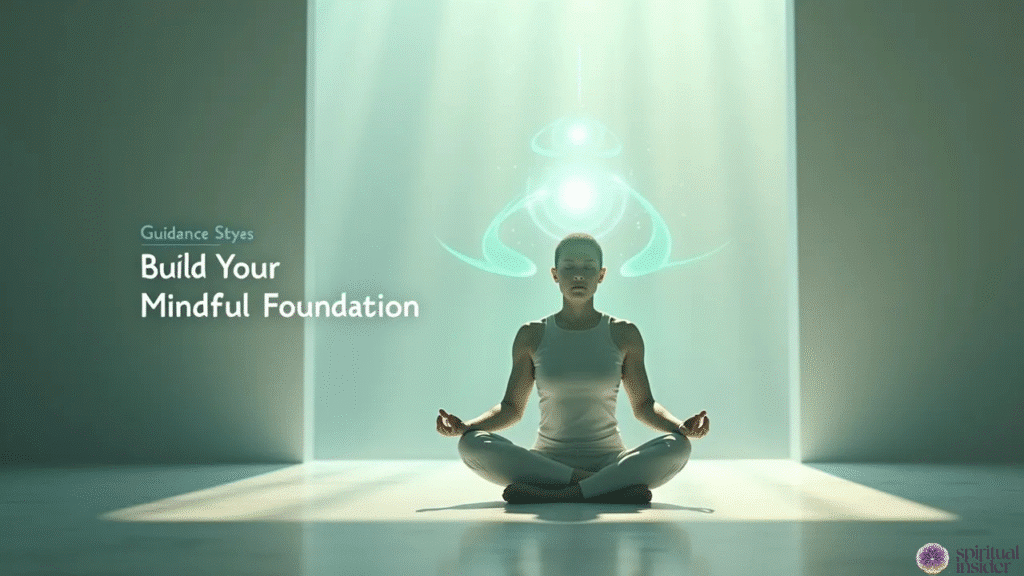
Guidance styles vary significantly, ranging from audio instructions to visual cues and instructor-led sessions.
Each approach offers unique benefits, with audio guidance providing consistent support while visual methods engage different learning preferences.
Self-guided approaches represent the most advanced form of practice, requiring developed awareness and discipline.
Many practitioners combine multiple guidance styles to create personalized experiences that adapt to their changing needs.
Common misconceptions about “doing it right” often prevent people from experiencing the full benefits of breathing meditation techniques.
The practice isn’t about perfect breath control but rather about developing awareness and acceptance of natural breathing patterns.
You may also like to read: Arcturian Starseed Birthmark & Traits
How Guided Mindful Breathing Meditation Works
The neurological pathway from breath awareness to brain state changes involves complex interactions between your respiratory system and nervous system.
When you focus attention on breathing, you activate the prefrontal cortex while simultaneously engaging the parasympathetic nervous system.
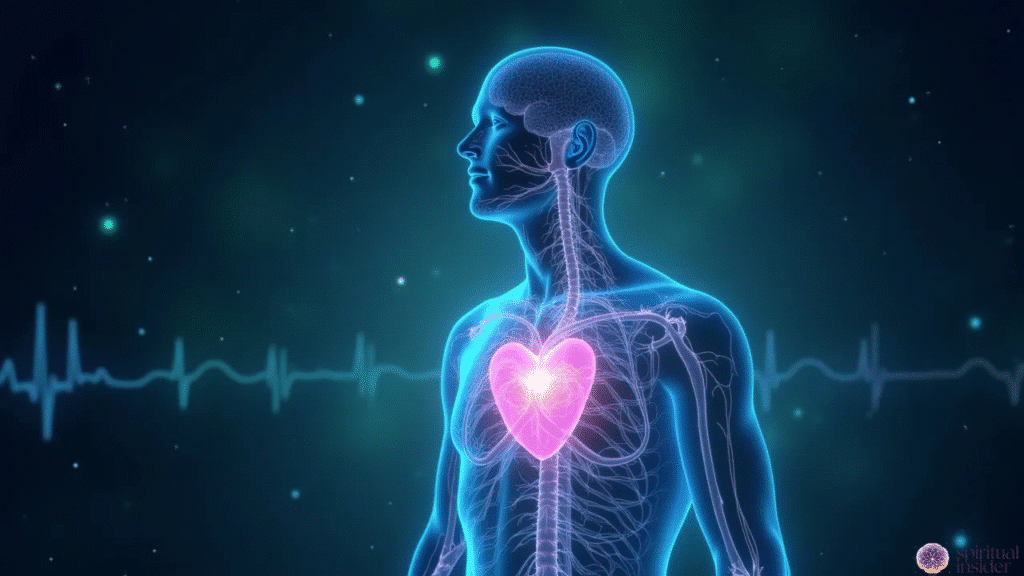
Vagus nerve activation occurs naturally during extended breathing practices, creating a cascade of physiological benefits.
This activation triggers the release of neurotransmitters like GABA and serotonin, which promote feelings of calm and well-being.
| System | Response Time | Effect |
|---|---|---|
| 🧠 Nervous | 30-60 seconds | Calming activation |
| ❤️ Cardiovascular | 2-5 minutes | Heart rate variability |
| 🫁 Respiratory | Immediate | Oxygen efficiency |
| 💪 Muscular | 5-10 minutes | Tension release |
| 🧪 Hormonal | 15-30 minutes | Cortisol reduction |
| 🛡️ Immune | 30-60 minutes | Inflammatory response |
| 🧘 Mental | 1-2 minutes | Focus enhancement |
| 😌 Emotional | 5-15 minutes | Mood stabilization |
Real-time physiological shifts include measurable changes in heart rate variability, cortisol reduction, and improved oxygen efficiency.
These changes occur within minutes of beginning practice and can be sustained for hours afterward with consistent training.
Crafting Your Personalized Practice
Assessment of your stress patterns, attention span, and learning preferences forms the foundation of effective mindfulness meditation for breathing.
Understanding your unique characteristics allows you to select techniques and timing that maximize benefits while minimizing resistance.
Choosing optimal timing involves experimenting with morning activation, midday reset, or evening wind-down sessions. Morning practice tends to set a positive tone for the entire day, while evening sessions promote better sleep quality.
Environment design creates your dedicated space without requiring perfectionism or expensive equipment. A quiet corner with comfortable seating and minimal distractions provides everything needed for effective practice.
Selecting guidance formats depends on your learning style and current skill level. Apps provide convenience and variety, while live instruction offers personalized feedback and community support.
| Practice Element | Beginner Choice | Advanced Option |
|---|---|---|
| 🕐 Duration | 5-10 minutes | 30-60 minutes |
| 🎧 Guidance | Audio apps | Self-guided |
| 🪑 Position | Comfortable chair | Traditional posture |
| 📱 Technology | Smartphone apps | Minimal tech |
| 🌅 Timing | Fixed schedule | Intuitive timing |
| 👥 Setting | Solo practice | Group sessions |
| 🎯 Focus | Single technique | Multiple methods |
| 📊 Tracking | Simple logging | Detailed metrics |
If you’re interested, check out: Guided Meditation On Acceptance
The Transformative Benefits of Mindful Breathing
Immediate effects occur within the first 30 minutes of practice, including measurable stress hormone regulation and muscle tension release. These rapid changes provide motivation to continue while offering instant relief from daily pressures.
Enhanced focus and mental clarity emerge quickly as the prefrontal cortex becomes more active. This improved cognitive function carries over into work, relationships, and creative endeavors throughout the day.
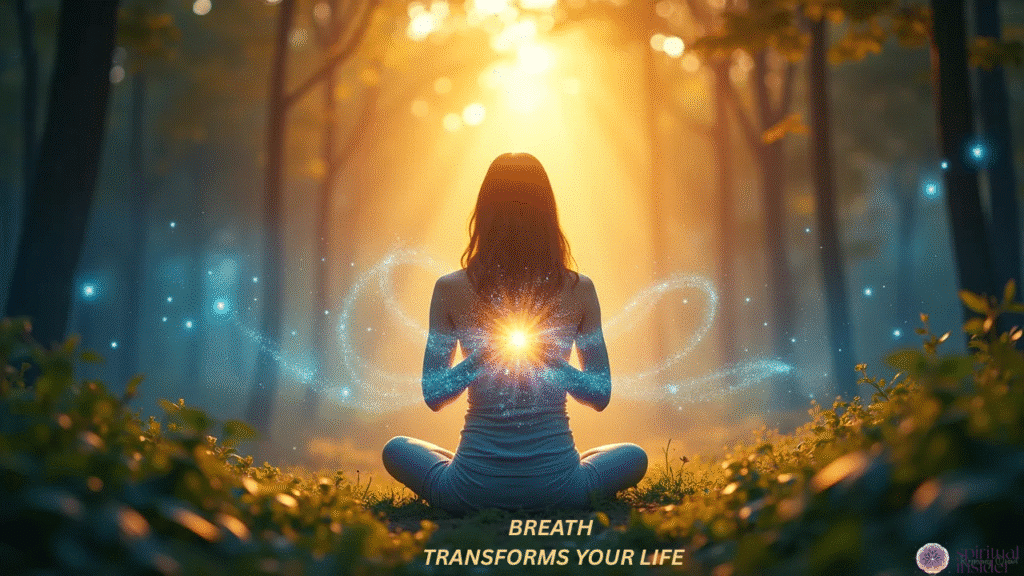
Emotional regulation and anxiety reduction represent some of the most sought-after benefits of breathwork meditation. The practice provides tools for managing difficult emotions without suppression or avoidance.
Short-term benefits manifest within one to eight weeks of consistent practice, including dramatically improved sleep quality and duration. Many practitioners report falling asleep faster and experiencing deeper, more restorative sleep cycles.
Long-term transformations require two or more months of consistent practice but offer the most profound benefits. Sustained attention span improvements affect every aspect of life, from work productivity to relationship quality.
| Timeframe | Benefit Category | Specific Changes |
|---|---|---|
| 🚀 0-30 min | Immediate | Stress hormone regulation |
| ⚡ 30-60 min | Quick | Enhanced mental clarity |
| 🌅 1-7 days | Short-term | Improved sleep quality |
| 🌱 1-4 weeks | Developing | Emotional resilience |
| 🌳 1-3 months | Established | Sustained attention |
| 🦋 3-6 months | Transformative | Stress response shifts |
| 💎 6+ months | Mastery | Deep self-awareness |
| 🌟 1+ years | Integration | Lifestyle transformation |
Building a Sustainable Practice
The 1% principle emphasizes tiny consistent efforts over perfectionist approaches that often lead to abandonment. Making small daily improvements creates momentum while avoiding the overwhelm that derails many meditation practices.
Creating habit stacks involves linking controlled breathing meditation to existing routines like morning coffee or evening tooth brushing. This connection leverages established neural pathways to support new habit formation.
Overcoming common obstacles requires understanding that restlessness, skepticism, and time constraints are normal parts of the learning process. Each challenge offers an opportunity to deepen commitment and develop problem-solving skills.
Community support and accountability systems provide encouragement during challenging periods while celebrating progress and breakthroughs. Many practitioners find that sharing experiences with others deepens their understanding and commitment.
The Role of Awareness in Breathing Practice
Distinguishing between concentration and open awareness represents a crucial skill in guided mindful breathing meditation. Concentration involves focusing intensely on a single object, while open awareness maintains relaxed attention that notices everything without attachment.
The observer self develops through consistent practice, creating a sense of witness consciousness that remains stable regardless of external circumstances. This observer can notice thoughts, emotions, and sensations without being overwhelmed by them.
Working with wandering mind as a feature rather than a bug transforms frustration into curiosity. Each moment of noticing distraction actually strengthens awareness and provides valuable information about mental patterns.
Breath serves as an anchor point for present-moment awareness because it’s always available and constantly changing. This accessibility makes it an ideal foundation for developing mindfulness skills that extend beyond formal meditation sessions.
| Awareness Level | Experience | Skills Developed |
|---|---|---|
| 🌱 Beginning | Scattered attention | Basic focus |
| 🌿 Developing | Improved concentration | Sustained attention |
| 🌳 Established | Stable awareness | Emotional regulation |
| 🌲 Advanced | Effortless presence | Intuitive wisdom |
| 🌟 Mastery | Continuous awareness | Spontaneous compassion |
| 💎 Integration | Natural flow | Unified consciousness |
| 🔮 Transcendent | Beyond self | Universal love |
| 🌈 Embodied | Living wisdom | Authentic expression |
The Science of Breath and Well-being
Respiratory physiology reveals how conscious breathing affects cellular function through improved oxygen delivery and carbon dioxide removal.
These changes occur at the mitochondrial level, enhancing energy production and reducing oxidative stress.
Neuroplasticity research demonstrates measurable brain changes from consistent breathing meditation techniques. Studies using fMRI scans show increased gray matter density in areas associated with attention, emotional regulation, and stress management.
Clinical studies on anxiety, depression, and PTSD treatment show remarkable success rates with structured breathing interventions.
Research indicates that mindful breathing exercises can be as effective as medication for certain conditions while offering no negative side effects.
Heart-brain coherence research reveals how rhythmic breathing creates optimal communication between cardiac and neural systems.
This coherence state enhances decision-making, emotional stability, and overall performance across multiple domains.
You might find this interesting: Spiritual Meaning of a Deer in Your Path
Advanced Techniques and Progression
Breath counting variations offer structured approaches to developing concentration and awareness.
The 4-7-8 technique involves inhaling for four counts, holding for seven, and exhaling for eight, creating a natural relaxation response.
Box breathing maintains equal counts for inhalation, retention, exhalation, and pause, typically using four to six counts per phase.
This technique proves particularly effective for managing anxiety and improving focus during demanding situations.
Coherent breathing uses a consistent five-second inhale and five-second exhale pattern, creating optimal heart rate variability.
This technique enhances emotional regulation and cognitive performance while being simple enough for beginners.
Visualization integration combines breathwork meditation with mental imagery to enhance effectiveness.
Color breathing involves imagining healing colors entering with each inhale while releasing tension or negativity with each exhale.
| Technique | Pattern | Primary Benefit |
|---|---|---|
| 🌬️ 4-7-8 Breathing | 4 in, 7 hold, 8 out | Anxiety reduction |
| 📦 Box Breathing | Equal counts | Focus enhancement |
| 🔄 Coherent Breathing | 5 in, 5 out | Heart coherence |
| 🌊 Wave Breathing | Natural rhythm | Stress relief |
| 🎯 Counted Breathing | 1-10 cycles | Concentration |
| 🌸 Belly Breathing | Diaphragmatic | Relaxation |
| 🧘 Alternate Nostril | Switching sides | Balance |
| 💎 Triangle Breathing | 3-part cycle | Integration |
Spiritual Meanings and Deeper Dimensions
Breath as Sacred Life Force represents the fundamental life energy that connects us to the universal source of all existence.
In Sanskrit tradition, “prana” encompasses the vital energy that sustains not only physical life but also consciousness itself.
When you engage in guided mindful breathing meditation, you’re participating in a sacred exchange with the universe itself.
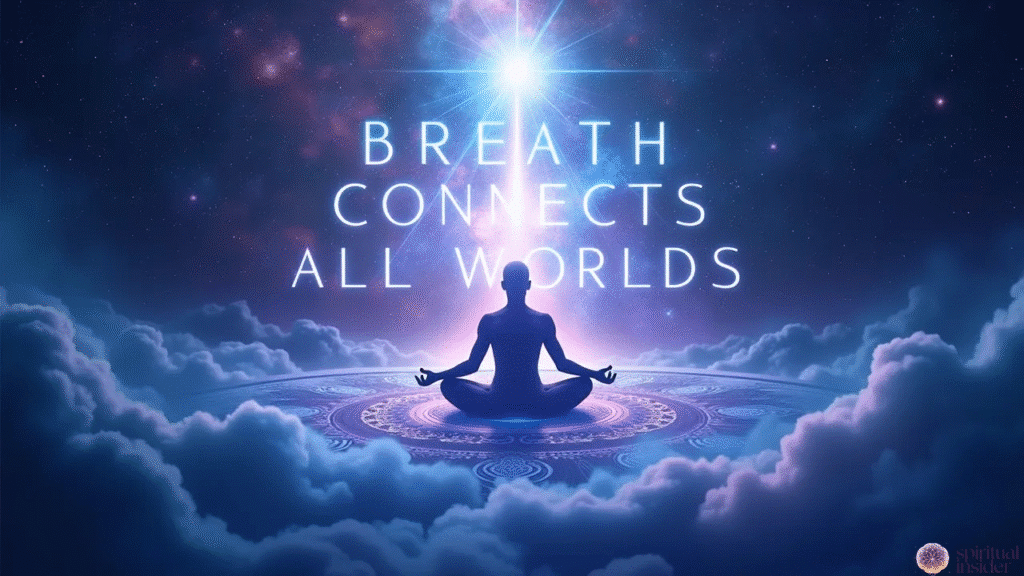
Each inhale draws in divine energy, cosmic wisdom, and infinite possibility, while each exhale releases limitations and outdated patterns.
The Bridge Between Worlds reveals how breathing serves as the sacred pathway connecting your physical existence with spiritual consciousness.
Your breath exists at the intersection of voluntary and involuntary action, making it the perfect vehicle for bridging conscious will with unconscious wisdom.
Each breathing cycle becomes a journey between the material and spiritual realms, with inhalation representing the descent of spirit into matter and exhalation symbolizing the return of consciousness to its source.
This rhythmic exchange creates a continuous dialogue between your human experience and your divine nature.
Continue on your article: Are Deer A Sign Of Angels?
Your Journey Forward
The integration of guided mindful breathing meditation into your daily life represents a commitment to personal transformation and spiritual growth.
Key takeaways for sustainable practice include starting small, maintaining consistency, and approaching the journey with patience and self-compassion.
Realistic expectations for transformation involve understanding that profound changes occur gradually through consistent practice rather than dramatic overnight shifts.
Most practitioners notice initial benefits within the first week, with deeper transformations emerging over months of dedicated practice.
Your breathing practice represents both a return to ancient wisdom and a step into the future of human consciousness.
Each conscious breath brings you closer to your true nature while contributing to the collective awakening of humanity toward greater peace and love.

Stella Henry is a dedicated spiritual researcher and expert blogger with over a decade of experience exploring metaphysical phenomena and consciousness. As a gifted intuitive and meditation practitioner, she brings profound insights to My Spiritual Insider through her well-researched articles on spiritual meanings, awakening, symbolism, and universal wisdom.

